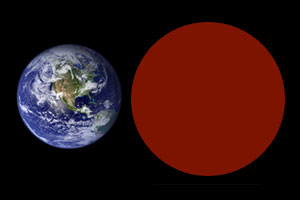 Size comparison between Earth and Kepler 10b.
Size comparison between Earth and Kepler 10b.
Delta Vega, Alderaan, Malacandra, Altair IV, Kepler 10-b. Which one of these worlds is not like the other? Answer: Kepler 10-b. Why? Because among the thousands of small, rocky, Earth-sized planets that we have come to know over the past century, Kepler 10-b is not a piece of fiction, but real.
After over a century of science fiction storytelling involving distant aliens worlds—many of which are depicted as being not so unlike Earth, right down to oddly similar vegetation, human-like inhabitants, and one particular rock formation that is the spitting image of one I’ve seen in the Mojave desert—NASA’s Kepler mission has made good on its “promise” to find an Earth-sized exoplanet. “Sci-Fa” has finally caught up with Sci-Fi….
Kepler 10-b: 1.4 times Earth’s diameter, 4.6 times Earth’s mass, and 8.8 grams per cubic centimeter average density. In all the physical categories, a heavy-weight compared to Earth’s newly (dare I say) demoted middle-weight status. Were you to stand on Kepler 10b’s surface, you would weigh about 2.3 times what you weigh on Earth. (Interestingly, that’s just a small bit less than you’d weigh if you could stand on the surface of Jupiter—if Jupiter had a solid surface, that is; imagine instead that you’re standing on a floating gas mining facility, like that one in the second Star Wars movie….)
